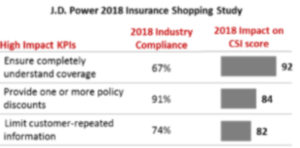Recently, well-known InsurTech startup Lemonade announced the launch of a new product initiative called Policy 2.0. According to Lemonade, the project is meant to simplify the language within a standard insurance policy so that insureds can easily understand what is and what is not being covered. Designed through an open-source platform, it will allow anyone from competitors to state regulators to contribute to its design—all toward meeting Lemonade’s core mission of making insurance simple for the end consumer.
While the project is still in its design phase (not scheduled for release until 2019, according to company sources) and is fraught with regulatory and legal challenges, the underlying premise of the initiative is exactly on target.
According to our J.D. Power 2018 Insurance Shopping Study, the No. 1 factor impacting customer satisfaction is understandability of coverages. Just 67 percent of consumers felt that their carrier had done a good job in ensuring they completely understood their policy coverages. Further, those companies that were able to meet customer expectations in this regard were able to achieve a 9 percent lift in their overall customer satisfaction scores.
 Lemonade’s Policy 2.0 initiative addresses this core issue while reinforcing three broader trends we are seeing across the property/casualty industry.
Lemonade’s Policy 2.0 initiative addresses this core issue while reinforcing three broader trends we are seeing across the property/casualty industry.
First, digital service providers are continuing to influence consumer expectations and preferences and have ushered in an era in which products and services must be relevant, personalized, easy and timely. Despite significant tech investment, the auto insurance industry has been playing catch-up with other consumer-facing industries on this front.
Second, consumers are empowered like never before, and as a result, insurance companies are making investments into customer experience improvements in order to attract and retain business. With less than 2 percent of new consumer entrants this year, growth requires taking share from a competitor. This puts a huge focus on conveying and delivering on value.
Third, this provides yet another example of InsurTech’s collective impact on the property/casualty industry. Of the $2.4 billion in seed funding that flowed into InsurTech last year, the majority focused on enhancing incumbents’ value chain rather than disrupting it. Lemonade’s Policy 2.0 provides yet another example of this movement.
While multiple challenges persist in taking Lemonade’s Policy 2.0 from concept to market across all 50 states, the over-arching principle of consumer-centric design should serve as a lesson to the nation’s largest insurers.





















 Heating Fuel Haulers Temporarily Exempt From Drive Time Limits
Heating Fuel Haulers Temporarily Exempt From Drive Time Limits  Underwriter, Actuary Fears of AI Drop; Work Needed on Collaboration
Underwriter, Actuary Fears of AI Drop; Work Needed on Collaboration  Final Sentencing in Large Scale Crop Fraud Case That Cost Insurers Nearly $35M
Final Sentencing in Large Scale Crop Fraud Case That Cost Insurers Nearly $35M  Why ‘Good Enough’ Is Killing Insurance: The Hidden Cost of Satisficing
Why ‘Good Enough’ Is Killing Insurance: The Hidden Cost of Satisficing 






